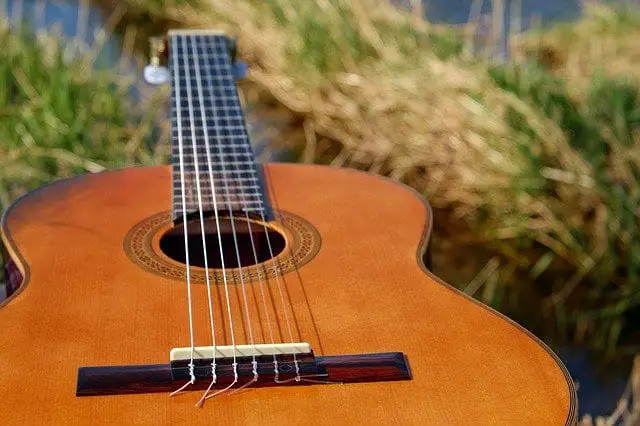Whether it’s for yourself or a loved one, buying a wooden guitar is an exciting prospect that requires sound decision-making. If you’re a pro guitar player, or know someone who is, the whole proposition gets much easier. If not, the sheer variety of models, sizes, and shapes can make the task look rather daunting. However, guitars are crafted instruments with loads of science going into the sound they produce. Once you understand this science, and figure out how a guitar’s construction impacts sound and other factors, decision-making gets a lot easier.
Here are some key elements to keep in mind when selecting a good guitar:
Acoustic or electric?
This is certainly one of the easier choices you’ll make when selecting a guitar. The choice between electric and acoustic guitars depends heavily on the type of music you’re looking to play. If you’re aspiring to play light country, folk, blues, classical, etc., an acoustic guitar with a clean tone will do the trick. On the other hand, if your taste veers towards rock and metal, you’re better off with an electric guitar.

Acoustic guitars rely on the shape, construction, and resonance of the body to amplify sound. Electric guitars, on the other hand, have pickups that translate string vibrations into electrical signals to create the sound. The latter require amplifiers for sound generation.
Then again, if you’re looking for the best of both worlds, there is always the acoustic-electric option. These hybrid wooden guitars are essentially acoustic guitars with pickups built-in. They are ideal for those looking to play in public spaces that require high volume output. They are also handy for artists looking to record their creations at home on their computers or other audio devices.
Understanding tone-wood and how it impacts sound
Wooden guitars are usually the preferred choice for most guitar enthusiasts, purely based on the material’s ability to resonate sound. The type of wood plays an integral part in determining the tonal quality of the guitar. While some have deeper, warmer tones, others have the ability to create brighter, more open sounds. In technical guitar jargon, this material is referred to as tone-wood.
Picking the right tone-wood, again, is a matter of personal preference. That said, having a good understanding of how tone-wood impacts sound will make the job much easier. Also, the type of wood also has obvious cost implications. The rarer the wood type, the more it’s going to cost you.
Here are some of the most commonly used tone-woods with their respective properties:
- Ash: Bright in sound, this type of wood is known to have good sustenance. Chords and notes tend to ring out for longer. This type of wood is the strongest, and also one of the most economical types of woods.
- Alder: This type of wood is light, and offers a rich, balanced tone performing well in low, mid, and high frequencies. It is relatively cheaper, and preferred for rock and blues music.
- Basswood: This tone-wood is softer and offers a balanced tone with slight warmth. It is affordable and commonly used in mixed-wood guitars.
- Cedar: A soft type of wood, cedar is known to create a bright tone. This type of wood is favorable for light playing techniques and is commonly used in classical and flamenco guitars.
- Mahogany: Strong and malleable, mahogany offers warmer tones with great resonance. A type of hardwood, this wood has a twangy, yet rich sound, and is a favorite amongst luthiers owing to its extra weight.
- Maple: Commonly used in fretboards and necks, maple wood is extremely hard, which lends it a bright tone. This wood is perfect for countering muddier tones caused by other woods in the guitar. It offers biting tones with a well-defined sound.
- Rosewood: Heavy in weight and aesthetically pleasing to the eye, rosewood is most commonly used to build fretboards. It creates a rich, velvety, and loud sound. However, it does come at a high cost owing to its rarity.
- Walnut: This type of wood is an alternative to mahogany material bodies and offers great midrange tones.
Other structural elements to keep in mind
The type of material used in wooden guitars is only one of the many elements that impact the sound and playing experience. Here are some of the other elements that are equally integral when picking a guitar:
· Neck type:
The neck of the guitar is secured to the body and ends at the headstock. It supports the fretboard and has a specially shaped back to accommodate the player’s hand used for fretting.
The three common types include set necks, neck-throughs, and bolt-on necks. Set necks are mounted onto the guitar body and secured using durable and heavy-duty glue. These types of necks are most commonly used in acoustic guitars, but can also be found in a few electric guitars. These types of guitars are believed to offer better sustain. However, they are not as easy to fix owing to the glue-on nature of their construction.
As the name suggests, bolt-on necks are secured to the guitar body using bolts, recessed joints, or screws. They are easier to repair.
Neck-through guitars are instruments with bodies and necks from a single piece of wood. These types of necks offer the best sustain. However, they are extremely difficult to fix if damaged.
· Body type:
Wooden guitar body types and sizes also play a major role in the quality of sound and comfort of playing. Here are some of the common body types with their properties:
- Concert and grand concert: Concert type guitars are compact in size and are ideal for smaller musicians. They offer a punchy mid-range with a bright tonal quality. Grand concert guitars are slightly larger and also have a stronger mid-range sound.
- Auditorium and grand auditorium: These guitars are medium-sized instruments with lower bouts. They are similar to dreadnought guitars, but have a narrow waist. These types of guitars offer a balanced tone and volume. Grand auditorium guitars have lower bouts that are wider than dreadnought guitars. That being said, they have narrower waists giving them an hourglass shape. They offer more balanced tones when compared to smaller guitars and also have a greater volume range.
- Dreadnought: A common style in acoustic guitars, these guitars have a large soundboard, square bouts, and relatively wider waists. They have a strong, driving sound that makes them a favorite with bluegrass guitar players.
- Jumbo guitars: They are large guitars that have lower bouts and are known to project loud tones with deep resonance.
- Travel and mini-acoustic guitars: These guitars are smaller in size, making them ideal for travelling or even smaller players or kids. They are made at about a 3/4 scale and are light and easy to pack.
· Finish:
While some may assume the finish of the guitar only impacts the visual appeal, it also has an effect on the tone of the sound it creates. Different types of finishes can influence the way the wood vibrates. That being said, this is usually a decision taken by the manufacturer. So, as a buyer, the best you can do is to pick up a guitar, and see if you like the sound. If you do, it’s safe to assume that the guitar has a favorable finish.
Once you have all these factors figured out, you will be in a well-informed position to make the right decision. However, keeping all this points at the back of your mind, it is still better to have a quick checklist to tick off before you seal the deal. Here are some key considerations to take before making a purchase:
- Neck and heel joints must be stable and free from cracks or any other forms of damage
- Bridges and other glued-on parts should be tight and secure
- The neck should be properly levelled with the top of the guitar
- Action (or string height) should be low at the first fret and all the strings should be comfortable to play. Also, playing through the strings should not create a buzzing sound.
- The keys used for fastening or loosening the strings should rotate easily, with minimum effort
- Use a tuner to check if the guitar stays in tune. If you play for a while and the tuning goes off, it’s not a good sign.
Once you’ve ticked all these boxes, you can be confident that you are ready to get a great guitar with the right sound. That being said, your personal preference is just as important as all the other listed pointers. You need to be sure the guitar you pick suits your taste in music and playing style. The guitar should also be in keeping with your proficiency level. In addition to this, the wooden guitar should be in a color of your choice and look visually appealing. At the end of the day, the end goal is to get an instrument that makes you want to play music each time you look at it.



